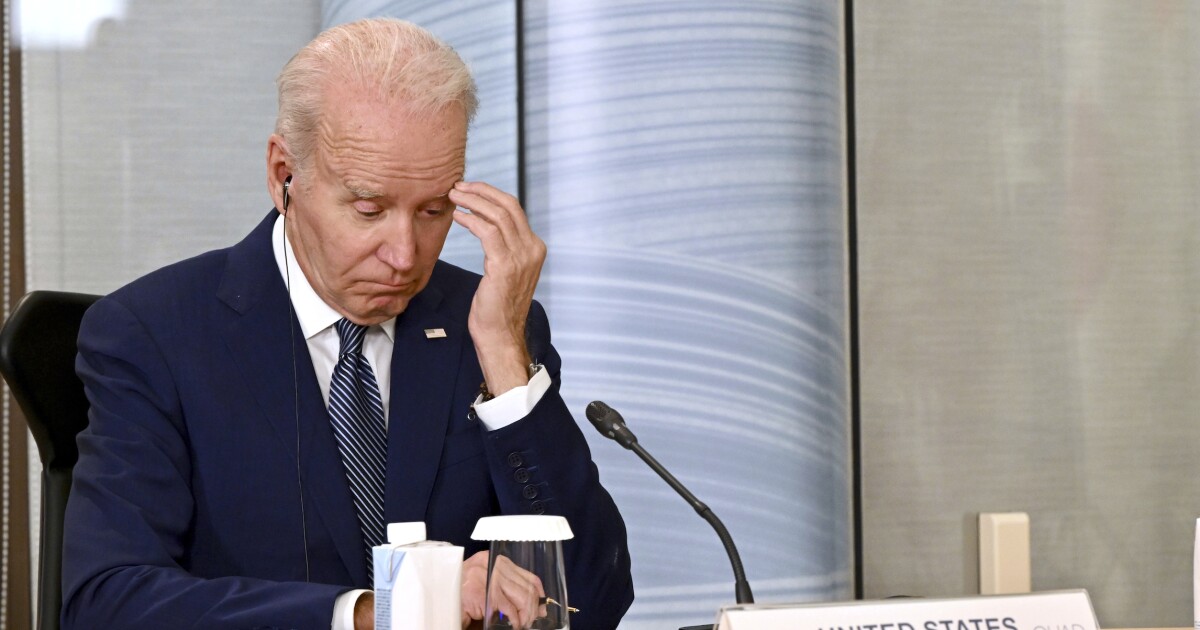

President Joe Biden has another headache emerging as he continues navigating the debt ceiling.
His $400 billion-plus student debt transfer is under attack on three different fronts, threatening to undo a campaign promise and nix a policy strongly favored by progressives and younger Democratic voters.
REPUBLICANS RIP BIDEN FOR TRYING TO INSERT TAXES IN DEBT CEILING DEAL
“President Biden’s student loan transfer scheme shifts hundreds of billions of dollars of payments from student loan borrowers onto the backs of Americans who did not agree to take out the loans,” Rep. Bob Good (R-VA) told the Washington Examiner on Monday. “I am proud to lead the fight against President Biden’s reckless, unilateral, and unauthorized action that would unfairly penalize those who worked hard to pay off their loans or who never took them out in the first place.”
Good and Sen. Bill Cassidy (R-LA) announced House Joint Resolution 45 in March, which would use the Congressional Review Act to repeal Biden’s program. Republicans have had success at passing resolutions under the Congressional Review Act through the House and Senate to Biden’s desk and fought against the debt transfer from the day it was announced.
The House is scheduled to vote on the resolution today.
Biden already promised to veto that bill if it reaches his desk, but he’s got more loans beef with the legislative branch. The Limit, Save, Grow Act, which is the only legislation to pass a chamber of Congress that would raise the debt limit, also includes language that would scrap the student loans plan. It’s now one of several sticking points the White House is negotiating with congressional leaders in debt ceiling talks.
“This resolution is an unprecedented attempt to undercut our historic economic recovery and would deprive more than 40 million hard-working Americans of much-needed student debt relief. If enacted, H.J. Res. 45 would weaken America’s middle class,” the White House said in a statement of policy.
The third front, and perhaps the biggest threat to the program’s survival, hails from the judicial branch. The Supreme Court heard arguments about the forgiveness plan’s legality on Feb. 28 and could rule it unconstitutional as soon as Thursday.
Under the student debt transfer plan announced last year, single borrowers earning up to $125,000 and married couples making up to $250,000 can have $10,000 in federal student loans canceled, while those who received Pell Grants during their schooling can have up to $20,000 wiped out. Those costs, which the Congressional Budget Office pegs at $400 billion, would be absorbed by taxpayers.
“[Ending the program] seems like a pretty obvious thing to do if you’re worried about the debt,” said Neal McCluskey, director of the CATO Institute’s Center for Education Reform.
McCluskey estimates a 70% chance the high court strikes the program, with a 30% chance they allow it to go through due to a lack of standing from plaintiffs.
Lowering student loan balances was a Biden campaign promise, though he spent his first 18 months in office saying that Congress needed to act first. McCluskey thinks Biden was never big on the idea of going it alone but felt pressured by his party’s progressive wing to act.
However, one silver lining if the court strikes it down is that Biden could try to avoid blame.
“Plan A is the Supreme Court allows the forgiveness of student loans, the Biden administration claims victory and reminds young voters during the campaign that it was Joe Biden who got their debt forgiven,” said Democratic strategist Brad Bannon. “Plan B, the court vetoes the student loan forgiveness and the Biden campaign beats up Republicans relentlessly for obstructing it. I’m sure they’re prepared either way.”
McCluskey agrees that’s a possibility but wonders if progressives could continue pressuring Biden to try again, perhaps by using the Higher Education Act of 1965 rather than accepting that there’s nothing to be done once the court rules.
The forgiveness plan rests legally on the HEROES Act of 2003, which was written with Iraq War veterans in mind, saying the economic stress of the COVID-19 national emergency necessitates canceling loans. The emergency itself expired May 11, but the Higher Education Act has its own language about altering loans and would not require the pandemic as a legal premise.
CLICK HERE TO READ MORE FROM THE WASHINGTON EXAMINER
The program was announced six weeks before the midterm elections and was credited with helping Democrats outperform expectations last November. The White House may be hoping for a similar result this time around regardless of whether loan forgiveness survives.
“Nearly 90 percent of the relief provided by the Department of Education would go to Americans earning less than $75,000 per year, and no relief would go to any individual or household in the top 5 percent of incomes,” the statement of administration policy reads. “Americans should be able to have a little more breathing room as they recover from the economic strains associated with the COVID-19 pandemic.”






